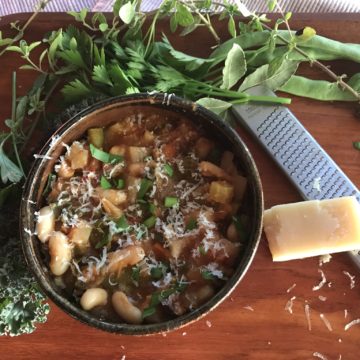So much of what I cook has to do with the fresh ingredients that happen to be on hand, as of course is true of most cooks. Right now our garden is bursting with organic veggies to harvest, which presented me with the challenge of what to do with some green pole beans, a big beautiful carrot, two kinds of kale and some very ripe tomatoes. I’ve been pining for some minestrone soup lately, and I was excited to have these fresh ingredients along with garden herbs and a good sized Parmesan rind stored in the freezer. I was all set!

While searching around for a good recipe, one that appeared to have some depth to it, I turned to Lidia Bastianich. She is great when it comes to classic Italian dishes, and I find her recipes both accurate and easy to follow. Of course, I adapted hers to fit my particular ingredients and tastes. I must say, the soup turned out very well – I made a large pot and leftovers were sadly gone the next day!
Soups are my “first love” when it comes to cooking and eating – I could definitely live on soup (and a good loaf of crusty bread to go with!). I of course take license with what ingredients I put in a soup – in fact, this is exactly what Lidia recommends depending on what’s seasonally available. So at the end of the day, you might not call this a “classic” minestrone, but it’s a”minestrone in spirit” and it definitely fulfilled my yearning!
I hope you will try it and take license to adapt it to the fresh ingredients you have on hand – there’s such joy and a real sense of accomplishment in doing so!

Loosely adapted from Lidia Bastianich's recipe, Minestrone - Vegetarian, or with Pork
Minestrone is a classic Italian vegetable soup - and yet it has many variations. We should feel free to adapt it to our desires and to what's readily available/seasonal, especially when it comes to fresh, ripe ingredients straight from the garden or market.
One commonly used variation is to throw in a rind that is left over from a block of Parmesan cheese. I dutifully save these up in my freezer to add to a soup or stew when that flavor and creaminess is desired. It really transforms the soup to a new level of deliciousness! Now if you don't have a rind, that's okay, you can just add some extra grated Parmesan at the end. Another substitution could be adding some basil pesto to your finished product - Yum!
I noted above that my recipe is "loosely adapted" from Lidia Bastianich because I don't use the pork the same way she does, along with other differences. One of my favorite tricks - or shortcuts, you might say - with soup is to add some chorizo for flavor (see my "Hearty Butternut Squash, Kale & Chorizo" soup on my Recipes page - where you can also read about a wonderful local source for the chorizo). This is totally optional, you can skip this step - I just happen to love the flavor and heartiness that a little bit of sausage lends to the dish.
I am also thrilled to have my own bay leaf tree - OMG what a difference it makes! If you live in South Florida, you can definitely grow it here. The fragrance in the dried leaves is unbelievable - nothing like the ones we buy. And then there's a variety of fresh herbs available in the garden at this time - I chose parsley, marjoram and garlic chives to enhance this soup.
Another variation is that I skipped using any kind of pasta here, as I wanted the firm, white potatoes in my soup - and I tend not to use both potatoes and pasta in the same dish. You can easily substitute a small pasta, such as a ditalini, for the potatoes - to each his own!
Last but not least, I must say that I am an opportunist when it comes to leafy greens that I harvest frequently from the garden. If I can find a way to incorporate it into a dish, I will - and so it snuck into my minestrone soup and added both flavor and nutrition, and nobody complained!
Please don't let the long list of ingredients scare you off - it's easy to make with readily accessible ingredients, and you're in for a rich and delicious pot of soup! Enjoy!
- 1/2 cup dried white cannellini or Great Northern beans or 1 can (or one cup canned)
- 2 Tb olive oil
- 1 large onion chopped
- 1 tsp salt, separated
- 1/2 tsp red pepper flakes crushed
- 1 piece chorizo sausage (about 1/3 lb), separated casing removed, roughly chopped
- 3 cloves garlic minced
- 3/4 lb fresh tomatoes, or one 14 oz canned roughly chopped
- 1 large carrot 1/4 inch sliced
- 2 stalks celery 1/4 inch sliced
- 2 medium potatoes 1 inch dice
- 3-4 qts hot water (or combined with chicken broth if desired)
- 1 Parmesan cheese rind (see note above)
- 1/4 cup fresh parsley leaves, roughly chopped
- 1/2 tsp fresh marjoram or oregano, chopped
- 3 bay leaves, dried
- 1/2 lb green beans trimmed, 1 inch sliced
- 2 small zucchini trimmed, 1 inch diced
- 1 handful fresh kale or other greens, destemmed roughly chopped
- 1/2 tsp black pepper freshly ground
- 1 handful garlic chives or chives, snipped into 1/2 inch pieces Optional
- 1/2 cup grated Parmesan cheese
- 1 baguette (optional)
-
If using dried beans, soak and cook the beans according to package instructions until just al dente - do not overcook Drain and set aside.
-
Heat 2 Tb olive oil in a large heavy pot (preferably enameled cast iron) over medium-low heat. Add onions, 1/2 tsp salt and red pepper flakes and cook until onions are softened.
-
Add the additional Tb of olive oil and one-third of the chopped chorizo to the pot with the onions and saute for two minutes, stirring and chopping the sausage with a spatula to incorporate (onions should take on some color from the chorizo). Add garlic and cook for an additional few minutes.
-
If using fresh ripe tomatoes, cut them in half and use your fingers to sweep the seeds out. Save as much liquid as you can in this process. Then roughly chop them into 1 inch dice and place them and all liquid into the pot. If using canned tomatoes, roughly chop them or crush with your hands directly into the pot along with all the liquid.
-
Add the carrots, celery and potatoes to the pot, along with the water/stock you are using, the Parmesan rind, herbs and bay leaves. The vegetables should be covered with liquid (add more as needed). Bring to a boil and allow to simmer partially covered on medium heat for 15 minutes.
-
Add the green beans and remaining sausage and simmer for an additional 5 minutes.
-
Add the zucchini (and kale/greens if using) along with the cooked, drained beans to the pot. Add more liquid if needed to cover the vegetables. You want a slightly thick, creamy soup so don't overdo it. Continue to simmer uncovered for 5-10 minutes, until the zucchini is cooked and still slightly firm (and the kale is tender but not mushy). Add black pepper and more salt to taste.
-
Sprinkle a generous amount of grated Parmesan cheese atop each bowl of soup. Add garlic chives if desired, and serve with crusty, toasted bread, Enjoy!
Photos & Writing by DK




